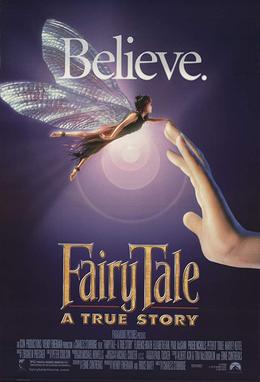FairyTale: A True Story facts for kids
Quick facts for kids FairyTale: A True Story |
|
|---|---|

North American theatrical release poster
|
|
| Directed by | Charles Sturridge |
| Produced by | Bruce Davey Wendy Finerman |
| Screenplay by | Ernie Contreras |
| Story by | Albert Ash Tom McLoughlin Ernie Contreras |
| Starring |
|
| Music by | Zbigniew Preisner |
| Cinematography | Michael Coulter |
| Editing by | Peter Coulson |
| Studio | Icon Productions Icon Entertainment International Wendy Finerman Productions Anna K. Production C.V. |
| Distributed by | Paramount Pictures (United States) Warner Bros. (International) |
| Release date(s) | 24 October 1997 (United States) |
| Running time | 99 minutes |
| Country | United States France |
| Language | English |
| Money made | $14 million |
FairyTale: A True Story is a fantasy drama film from 1997. It was made in France and America. Charles Sturridge directed the movie. Bruce Davey and Wendy Finerman produced it. The film tells a story inspired by the famous Cottingley Fairies. It is set in England in 1917. The plot follows two young girls. They take a photo that many believe shows real fairies. This photo was thought to be the first proof of fairies. Icon Productions made the film. Paramount Pictures released it in the United States. Warner Bros. distributed it in other countries. The movie came out in the U.S. on October 24, 1997.
The Story of the Fairy Photos
The movie takes place in England during World War I. This was a time of big changes. New things like electric lights and cameras seemed almost magical. Some people believed in "spiritualism." This was the idea that you could talk to spirits. Famous writer Arthur Conan Doyle believed in it. His friend, magician Harry Houdini, did not. Houdini often showed how fake spirit mediums tricked people.
Young Frances Griffiths comes to live with her cousin Elsie Wright. Frances's father is away fighting in the war. Elsie's family lives in the countryside of Yorkshire. Elsie's mother, Polly, is very sad. Her son Joseph, Elsie's brother, died when he was ten. Polly keeps his room exactly as it was. Elsie is not allowed to play with his toys. But Elsie has Joseph's unfinished fairy house. She keeps it in her attic bedroom. Her father, Arthur, tells her many fairy tales.
Arthur is good with new technology. He helped bring electricity to the local mill. He is also an amateur photographer. When Frances arrives, she and Elsie find they both love fairies. They meet fairies down by a brook called the "beck." One afternoon, they borrow Arthur's camera. They want to take pictures of the fairies. They hope these photos will cheer up Polly.
Polly goes to a meeting where people talk about angels and other magical beings. When she gets home, Arthur is looking at the photos. He can't believe what he sees. But Polly thinks the photos are real. She shows them to a lecturer named E.L. Gardner. He has a professional check the photos. They say the photos are real, or at least not faked. Gardner then shows the photos to Arthur Conan Doyle.
Famous People Get Involved
Most people believe the photos are real. They think young children could not fake them. Only Harry Houdini thinks it might be a trick. Arthur Conan Doyle visits the girls' home. He brings Houdini, Gardner, and two new cameras. Arthur tells Houdini he doesn't believe in fairies. But he also says no trickery happened in his darkroom.
Elsie and Frances soon take two more photos. Arthur Conan Doyle publishes the story in The Strand Magazine. He promises to change everyone's names. But a news reporter finds out where the girls live. He traces them through the local school. Soon, many people come to the village. They want to see the fairies. The fairies get scared and leave because of the crowds. To say sorry, the girls finish Joseph's fairy house. They leave it in the forest as a gift for the fairies.
The girls are invited to London by Arthur Conan Doyle. They enjoy being famous. They also see Harry Houdini perform. Backstage, Houdini asks Elsie if she wants to know his magic secrets. She wisely says no. Houdini tells a reporter, "Masters of illusion never reveal their secrets!"
Back in Yorkshire, the newsman breaks into the girls' house. He finds paper dolls shaped like fairies in Joseph's room. But he gets scared by a vision of a young boy. He leaves the evidence behind. After the girls return home, the fairies reappear. And finally, Frances's father comes home from the war.
Meet the Cast
- Peter O'Toole as Sir Arthur Conan Doyle
- Florence Hoath as Elsie Wright
- Elizabeth Earl as Frances Griffiths
- Harvey Keitel as Harry Houdini
- Paul McGann as Arthur Wright
- Bill Nighy as Edward Gardner
- Phoebe Nicholls as Polly Wright
- Anna Chancellor as Peter Pan
- Mel Gibson as Sergeant Major Griffiths
- Don Henderson as Sydney Chalker
Behind the Story
The film FairyTale: A True Story is based on real events. In 1920, Sir Arthur Conan Doyle became very interested in spiritualism. He was the writer who created Sherlock Holmes. The Strand Magazine asked him to write an article about fairies. While working on this, he heard about the Cottingley Fairies.
In 1922, he wrote a book called The Coming of the Fairies. It included many photos and discussions about them. Magician Harry Houdini was famous for showing how fake mediums tricked people. He wanted to find a real medium to talk to his late mother. Conan Doyle and Houdini were friends for years. They wrote letters to each other about supernatural things.

